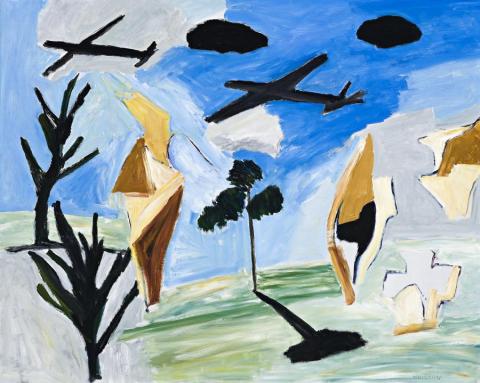HILLTOP, 1975
KEN WHISSON
oil on composition board
86.5 x 107.0 cm
signed lower right: WHISSON
inscribed verso: “HILL TOP” / “HILLSIDE” / PAINTED ST KILDA 1975 / ...
Watters Gallery, Sydney (label attached verso)
Private collection, Brisbane
On Ken Whisson's return to Australia in 1970 he produced, over the following seven years, a body of work that included some of his best paintings. Outstanding among these is Disembarkation at Cythera (Idiot Wind), 1975 in the collection of the National Gallery of Australia, Canberra. Leaving its references to Watteau and the theme of love aside, images embrace ships and people recalled from the view through his flat window in St Kilda. The slightly earlier painting Jean's Farm, 1972, also in the National Gallery's collection, presents a more immediate sense of recollection that is engaging, described by gallery curator Michael Wardell as being 'uncharacteristically grounded in actual events'.1 Wardell traces its genesis to a weekend visit to the country with friends, recollected and peopled with agitated movement. This same intuitive liveliness informs Hilltop, 1975 in Whisson's response to the landscape around him. Layered with meaning like all his work, paradox lies at its heart in the tension between immediacy and recollection. While spontaneity may seem in conflict with recollection, the outcome is completely in accord with the artist's approach. Of his working method, Wardell quotes Whisson as saying, 'I just prepare a piece of canvas, a stretched canvas, white, clean. Sit down in front of it for half or three quarters of an hour till I haven't the faintest idea what I am going to do, and then I start painting.'2 This may partly answer why his art is sometimes described as enigmatic. Yet, it is completely in accord with his commitment to the act of painting. Again Whisson provides the answer, 'Creative art is above all immediate and intuitive. Intelligence, accumulated knowledge and even prolonged labour, can be factors; but the decisive factor is the sweeps of intuitive energy that bring together, and make into an indivisible totality, all these and a multitude of other elements.'3 Feeling and 'intuitive energy' fill Hilltop, as do subjects from the everyday, of landscapes with trees (shadow more substantial than reality) and other floating shapes, of sky, clouds and aeroplanes created in his idiosyncratic iconography, almost two dimensional. There is also the unique handling of pictorial space. His paintings create their own ambiguous space, with a dynamic interaction between the emphasis on the picture plane, where much of the action lies, and depth. Birds and aircraft reflect an interest in flight and escape from the terrestrial. Bombers take on the political and war. In 1987 Whisson was awarded the Australia Council's Visual Art Board's Emeritus Award for his substantial contribution to Australian art. A major exhibition of his work, Ken Whisson: As If, was presented by Heide Museum of Modern Art, Melbourne in early 2012.
1. Wardell, M., 'Ken Whisson: St Kilda to Perugia', Art and Australia, Sydney, vol. 22, no. 2, Summer 1984, p. 195
2. The artist, quoted in ibid
3. The artist, quoted in Dury, N., Images 2: Contemporary Australian Painting, Craftsman House, Sydney, 1994, p. 50
DAVID THOMAS
